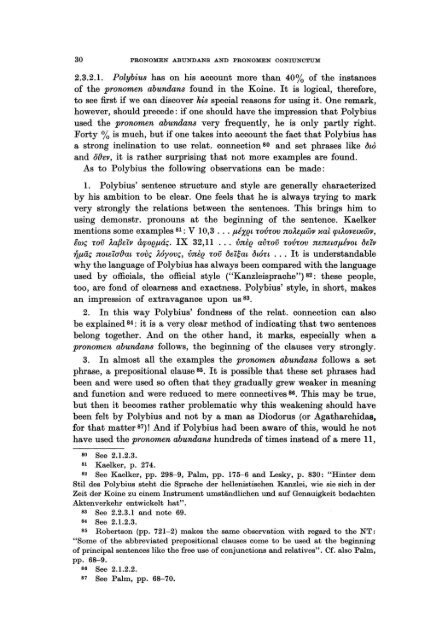Pronomen Abundans and Pronomen Coniunctum. A ... - DWC
Pronomen Abundans and Pronomen Coniunctum. A ... - DWC
Pronomen Abundans and Pronomen Coniunctum. A ... - DWC
Create successful ePaper yourself
Turn your PDF publications into a flip-book with our unique Google optimized e-Paper software.
30 PRONOMEN ABUNDANS AND PRONOMEN CONIDNCTUM<br />
2.3.2.1. Polybius has on his account more than 40% of the instances<br />
of the pronomen abundans found in the Koine. It is logical, therefore,<br />
to see fust if we can discover kis special reasons for using it. One remark,<br />
however, should precede: if one should have the impression that Polybius<br />
used the pronomen abundans very frequently, he is only partly right.<br />
Forty % is much, but if one takes into account the fact that Polybius has<br />
astrong inclination to use relat. connection 80 <strong>and</strong> set phrases like !5tO<br />
<strong>and</strong> ö#ev, it is rather surprising that not more examples are found.<br />
As to Polybius the following observations can be made:<br />
1. Polybius' sentence structure <strong>and</strong> style are generally characterized<br />
by his ambition to be clear. One feels that he is always trying to mark<br />
very strongly the relations between the sentences. This brings him to<br />
using demonstr. pronouns at the beginning of the sentence. Kaelker<br />
mentions some examples 81: V 10,3 . .. f-téx(!t -rov-rov noÄ.ef-twv "ai cptÄ.ovet"wv,<br />
lwç -rov Ä.afJelv àcpo(!f-táç. IX 32,11 ... vnè(! av-rov -rov-rov neneu:1f-tÉvot !5eiv<br />
TJf-täç notela#at -rovç Myovç, vnè(! -rov &t:~at &6n ... It is underst<strong>and</strong>able<br />
why the language of Polybius has always been compared with the language<br />
used by officials, the official style ("Kanzleisprache") 82: these people,<br />
too, are fond of clearness <strong>and</strong> exactness. Polybius' style, in short, makes<br />
an impression of extravagance upon us 83.<br />
2. In this way Polybius' fondness of the relat. connection can also<br />
be explained 84: it is a very clear method of indicating that two sentences<br />
belong together. And on the other h<strong>and</strong>, it marks, especially when a<br />
pronomen abundans follows, the beginning of the clauses very strongly.<br />
3. In almost all the examples the pronomen abundans follows a set<br />
phrase, a prepositional clause 85. It is possible that these set phrases had<br />
been <strong>and</strong> were used so of ten that they gradually grew weaker in meaning<br />
<strong>and</strong> function <strong>and</strong> were reduced to mere connectives 86. This may be true,<br />
but then it becomes rather problematic why this weakening should have<br />
been feIt by Polybius <strong>and</strong> not by a man as Diodorus (or Agatharchidas,<br />
for that matter 87)! And if Polybius had been aware of this, would he not<br />
have used the pronomen abundans hundreds of times instead of a mere 11,<br />
80 See 2.1.2.3.<br />
81 KooIker, p . 274.<br />
82 See Kaelker, pp. 298-9, Palm, pp. 175--6 <strong>and</strong> Lesky, p. 830: "Hinter dem<br />
Stil des Polybius steht die Sprache der hellenistischen Kanzlei, wie sie sich in der<br />
Zeit der Koine zu einem Instrument umständlichen und auf Genauigkeit bedachten<br />
Aktenverkehr entwickelt hat".<br />
83 See 2.2.3.1 <strong>and</strong> note 69.<br />
84 See 2.1.2.3.<br />
85 Robertson (pp. 721-2) makes the same observation with regard to the NT:<br />
"Some of the abbreviated prepositional clauses come to be used at the beginning<br />
of principal sentences like the free use of conjunctions <strong>and</strong> relatives". Cf. also Palm,<br />
pp. 68-9.<br />
86 See 2.1.2.2.<br />
87 See Palm, pp. 68-70.
















